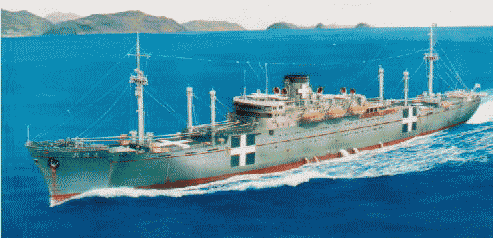

The American Red Cross, in response to a statement by the Japanese Government that it might consent to receive supplies from Soviet territory, shipped urgently needed food and medical supplies to Siberia. As agreed, in December 1943, 2,200 tons of Red Cross supplies were packaged for distribution to British, Canadian, American, Dutch and other Allied POWs and civilian internees held by Japan throughout the Far east. Five lend-lease ships built in Portland, Oregon were loaded with the supplies and sailed for Nakhodka, Siberia.
The Japanese failed to pick up the urgently needed food and medical supplies in a timely manner. Finally, in October 1944, after the Red Cross stocks had lain in Soviet warehouses for almost a year, the Japanese government agreed to send a ship to Nakhodka. In November 1944, the Japanese informed the U.S., via the International Red Cross Committee in Geneva, that the relief supplies would be distributed to POWs in Japan proper and other localities as far south"as feasible." That same month, cargo ship HAKUSAN MARU picked up the supplies at Nakhodka and transported them to Kobe.
From Japan, the goods were to move to the POW camps in two ships. HOSHI MARU would transport 275 tons of relief supplies to Shanghai and AWA MARU would transport the remaining supplies to Southeast Asia. Both ships were able to carry a far greater amount of cargo than the POW supplies and the Japanese crammed war materiels aboard both vessels. The first to leave was HOSHI MARU. Through the Swiss, the United States was informed of the exact time and course of HOSHI MARU for the relatively short five-day run to Shanghai and she arrived without incident.
Japan next set about to plan the more complex trip of AWA MARU. She was scheduled to leave Japan in February 1945, call at Formosa, Hong Kong, Saigon, Singapore and several Javanese ports, then return to Japan via Singapore and the Formosan Strait. AWA MARU would be specially marked with white crosses on her sides, funnels and hatch covers. The white crosses would be electrically illuminated, and at night she would run with all navigational lights on.
After delivering the Red Cross supplies to Allied POWs at Singapore and Java, AWA MARU was returning to Japan under a safe passage guarantee, when, in foggy weather, she was sunk mistakenly by an American submarine.
The ships used in the two civilian exchange operations of 1942 and 1943 were the only means by which relief supplies for Allied POWs and internees were able to reach the Far East, apart from the single trip by HAKUSAN MARU that picked up supplies at Nakhodka in 1944. The International Red Cross Committee estimated that, over the whole war period, the Japanese received 225,000 Red Cross parcels for distribution to the 300,000 Allied nationals estimated to be held by Japan.
As documented in post-war POW affidavits, even after receipt of Red Cross packages, most of them were withheld by the Japanese. The boxes were delivered to POW camp sites across the Pacific, but locked in warehouses. The Japanese refused to allow Red Cross medicines and surgical instruments to be used. In August 1945, complete chests of Red Cross surgical equipment were found unopened in many camps.
One camp reported that on Christmas day, 1944, its POWs were issued a full meal of Red Cross food and regular Japanese rations. Thereafter, for a few weeks, the POWs received small daily portions of Red Cross food. During February 1945, all milk furnished by the Red Cross was given to the hospital patients and small amounts of Red Cross food were issued occasionally totaling less than two boxes per man during a 3-month period. According to POW accounts, the Japanese retained the rest of the Red Cross supplies and medicines for themselves.
At another camp, no Red Cross supplies were received after 1 May 1945, but the POWs received three shipments of books by the YMCA. On 15 August 1945, POWs in various camps in Japan learned of the surrender when they were given Red Cross food packages for the first time during their long captivity.
|
Awa Maru
(revised 11/8/2018) |
|
Hakusan
Maru(revised 2/1/2017) |
|
Hoshi
Maru (posted 10/10/2009) |

Bob Hackett is a military historian and researcher. Retired from the United States Air Force and later from the aerospace industry, he resides in the United States.
Mr. Sander Kingsepp of Estonia is also a military historian and researcher. A talented linguist, Sander's translations of Japanese source materials have added immeasurably to these TROMs.
Questions to the authors concerning these TROMs should be posted on the Discussion and Questions board.

